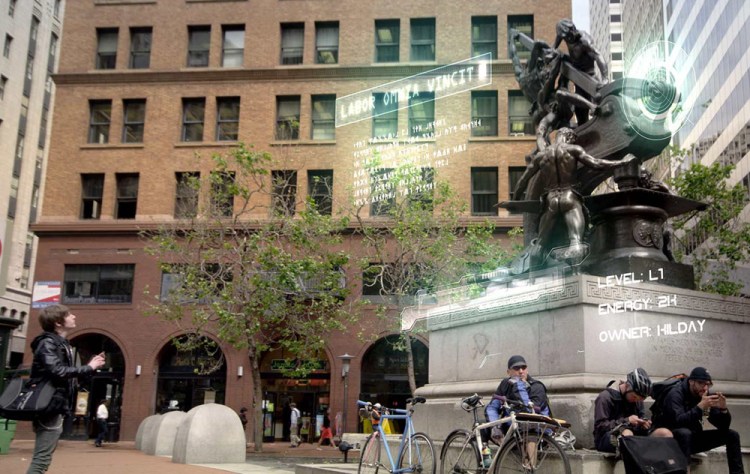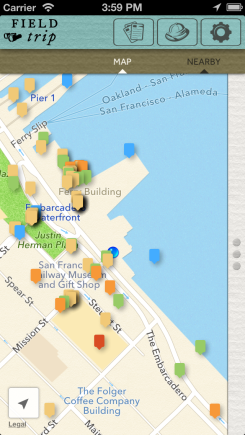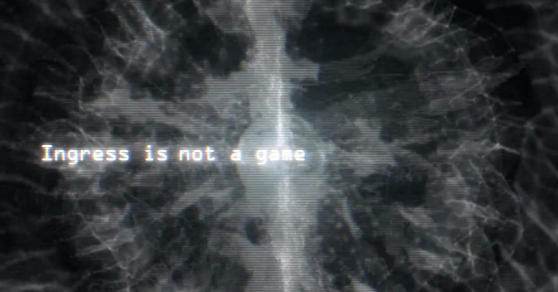 “The world around you is not what it seems,” says Ingress, the virtual game that uses the real world as its gamespace. And, perhaps, when Google’s semi-independent division Niantic Labs is finished with its mission, we humans won’t be, either.
“The world around you is not what it seems,” says Ingress, the virtual game that uses the real world as its gamespace. And, perhaps, when Google’s semi-independent division Niantic Labs is finished with its mission, we humans won’t be, either.
Google’s mission is to organize the world’s information and make it universally accessible and usable. Note carefully that Google says nothing about the Internet in that statement.
In the last few eye-blinks of human history, we’ve created virtual worlds: cyberspace, virtual reality, the World Wide Web … places that exist in our devices, on our computers, in our servers, on the internet, and in our heads. But there’s also a space in which we live and walk and eat and breathe. Realspace. Meatspace. IRL. The real world, so we say, that we can touch and taste and smell.
Google’s trying to bring those world together, partly through the work of Niantic Labs.
Augmented reality is nothing new, of course, with marketing-focused companies like Layar building connections between physical and virtual reality and Ikea’s most-downloaded branded app of 2012 doing similar things. Other startups have explored AR capabilities as well, such as Caterina Fake’s Findery, which invites people to leave geo-tied notes that others can discover and read.
But when a company with the resources of a Google tackles the problem, and has a tool in Google Glass that seems destined for significant developer (and probably user) penetration that can actually create interconnections between the real and the virtual perhaps more efficiently than any other previous product, you’ve got something interesting. And potentially huge.
So a couple of weeks ago, I chatted with the man who’s leading that effort.
John Hanke: the missionary of mapping
John Hanke is vice president of product for Niantic Labs, the year-old Google-but-not-Google division of just a few dozen engineers that brought us Field Trip, the app to explore the world around us with a virtual docent. And, of course, the virtual/real game Ingress.
Before Niantic, Hanke ran Google Maps, Google Earth, and other geo areas, and before Google, he was the cofounder and CEO of Keyhole, the innovative geo-mapping and visualization company. Google bought Keyhole in 2004, which brought Hanke in the search engine’s fold to lead the its maps, earth, street view, and local divisions.
Now, he told me, rather than let him leave to scratch his entrepreneurial itch yet again and do another startup, Google gave him a semi-autonomous group to, as his LinkedIn profile suggests, experiment at the “intersection of mobility, real world, and the Internet.”
“We set up Niantic as a group that could explore new types of mobile apps with ubiquitous always-on features,” Hanke said. “And we’re set up to act like a start-up.”
Virtual + physical = field trip
Field Trip was one of Niantic’s first creations, and while on the surface it’s an app that helps you find cool stuff, ultimately it’s a tool to merge metadata and data and then present them together. While you’re in the physical world, Field Trip pulls data about that experience from digital sources, feeding you that information, and changing — deepening, enriching — your experience of place. Layering with with history, perhaps, or science, or culture.
Because, after all, one rock is very much like another rock, but if this is the precise rock where Geronimo attacked Mexican soldiers armed with only a knife and his courage, that changes our experience of this particular place. And the merging/melding/layering of virtual and physical makes it more real, in a sense — hyperreal.
Enabling that, of course, requires extensive virtual enhancement of the what-you-see-is-what-you-get world.
“One of the things that we’re trying to evangelize is the concept of geo-tagging everything,” Hanke told me. “I would have expected eight years ago that it would be ubiquitous now, but it’s still not. But I think we’ll get there.”
Geotagging everything digital is a key intersection point between virtual and real. If this blog post is written here, and not there, that adds flavor and nuance to the information. And if a particular historical fact is geotagged to a specific mapped location, that adds depth and dimension to our experience of that place.
“We’re applying some of the same techniques we currently use in standard web search, and the same kind of discipline, to pull really interesting, really good places up from everything else,” Hanke says. “The model is that you’re walking through an unfamiliar neighborhood, but with a friend who is telling you the best things around you. You enjoy it just like before, but you’re a little more informed.”
AR + MMO + IRL
Depth and dimension are definitely core components of Ingress, another Niantic Labs app/experiment/game. Ingress is a — take a deep breath — augmented reality massively multiplayer online video game.
The real world is real, but it’s fought over virtually by two shadowy groups: the Enlightened and the Resistance. Niantic has filled the Earth with virtual portals, usually coincident with actual physical landmarks or monuments, that players need to capture in order to gain territory. Capture territory with large numbers of people (aka “mind units”) and your faction gets more powerful.
Clearly, the massive integration of Google mapping technology with a sophisticated gaming engine is required. And the result is another intersection between the real and the virtual.
“Ingress is a massively multiplayer online game designed for mobile, with real location-based connections,” Hanke told me.
You play with everyone in your faction, and you might meet up with other players in real life, or you may just know them virtually as team members in another area. Along the way, Google learns an awful lot about how you use your mobile devices, about mapping physical locations, and about overlaying cyberspace on meatspace.
All of that knowledge is going to come in very handy with Google Glass.
Endgame: Google Glass?
Hanke is cautious when speaking about Google Glass, as is the PR handler who is copiloting our conversation. Even already public information is a question mark as we chat: Google is definitely being Apple-like in the control and distribution of Glass and its future.
But something tantalizing tidbits do come out.
“We definitely kinda had Google Glass in mind when we started work on apps at Niantic,” Hanke says. “We need mobile devices that are less intrusive than the phone is.”
And we need devices with different input/output modalities, he says. After all, it’s not easy to play Ingress running around holding an expensive and fragile device in front of you like a window ripped from its frame. And yet you need that portal from the physical to the virtual. For instance, while Field Trip is great to open the doors on human context for the world around us, it threatens to detract from our experience of the world by redirecting our eyes from the ultimate big screen of reality to the small screen of our mobile device.
Google Glass, on the other hand, sits unobtrusively on our foreheads, leaving our hands free and providing data as an overlay on top of the physical world rather than an alternative to the physical world. That model of layering, mixing, and intersecting is top-of-mind for Hanke.
“It just can’t be the case that people are walking around heads down tapping on a screen,” he says. “That just can’t be the future of the human race.”
Cyborg me now
Which, of course, is exactly what’s at issue: the future of the human race. Or, at least how we ingest, consume, and reconstitute digital data. And analog data. And meld the two into one harmonious whole of knowing.
That’s perhaps a little metaphysical for a small division of Google that focuses on maps and games and apps.
But the web has rewired our brains in a decade or so of virtually ubiquitous Internet access, and the smartphone has rewired our behavior in five years, taking us from creatures who look up to to see others to beings that look down at any opportunity to see small bits of plastic and glass and metal in our hands.
So is it really too much to expect from a transformation that brings us from clear divisions between what is real and what is virtual to an elegant blend of the two?
“This is not psychosis or some cognitive break, but an actual takeover of the mind,” Google’s introductory video for the Ingress game says ominously.
Art imitates life, I suppose, and life, in turn, imitates art.
VentureBeat's mission is to be a digital town square for technical decision-makers to gain knowledge about transformative enterprise technology and transact. Learn More







